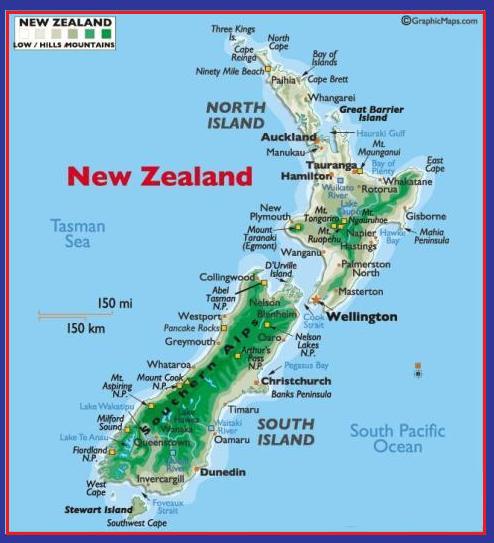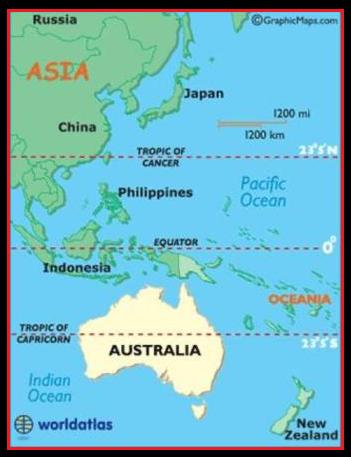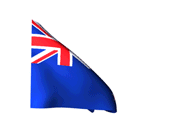|
Over 1,000 years ago waves of Eastern Polynesians arrived in New Zealand and
its outer islands. A unique culture developed, and descendents of the original
Maori people survive to this day.
In 1642, the coastline of South Island was sighted by the Dutch East India
Company explorer, Abel Tasman. There were brief encounters with the Maori as his
crew tried to come ashore. A few of his sailors were killed, but the Captain
himself never set foot on land.
In 1769, the legendary
British
explorer, James Cook, sailed into New Zealand waters and mapped most of the
shoreline. After news of these unspoiled islands spread across the far-reaches
of the globe, a hardy group of traders and whalers were quick to arrive.
 Small settlements sprang up along the northern coastline, and a trading culture
with the Maori flourished. For centuries - with just clubs and spears - the
Maori fended off their enemies, but now with
European metal
and muskets in their hands, they imposed their will on their neighbors and
tribal warfare surfaced for a time. Small settlements sprang up along the northern coastline, and a trading culture
with the Maori flourished. For centuries - with just clubs and spears - the
Maori fended off their enemies, but now with
European metal
and muskets in their hands, they imposed their will on their neighbors and
tribal warfare surfaced for a time.
As interest in the New Zealand territory peaked across
Europe, and in
an effort to keep the
French
out, the British government made their move; they agreed to recognize the
sovereignty of the Maori people and appointed William Hobson as the region's
Lieutenant Governor. He worked under the authority of the
British
Governor of
New South Wales,
Australia.
In 1840, Hobson, in his new role, arrived on North Island. Subsequently, Maori
chieftains entered into a compact with Britain called the "Treaty of Waitangi."
They ceded sovereignty to
Britain's
Queen Victoria while retaining territorial rights - at least on paper.
With
British sovereignty now firmly asserted, Queen Victoria signed a royal
charter for New Zealand to become a Crown colony separate from
New South Wales, and Hobson was sworn in as the colony's first Governor.
With the
British in charge, scores of settlers from the
British
Isles arrived and organized colonial settlements were built. At first the
Maori welcomed them, but the inevitable conflicts over land rights brought land
wars to New Zealand in 1843 and 1872. As a result, the Maori people were pushed
out of their ancestral lands.
After the New Zealand Parliament met for the first time in 1854, responsible
local government was in place and eventual independence was a passionate dream.
Among the first British colonies to be declared a dominion, the
British
colony of New Zealand became an independent (self-governing) dominion in 1907.
Throughout the 20th century New Zealand remained a supportive member of
the
British Empire, fighting side-by-side in major wars, including World
Wars I and II. On April 25 (ANZAC Day), New Zealand
commemorates the anniversary of the landing of troops of the
Australian
and New Zealand Army Corps during World War I at Gallipoli, Turkey.
The economics of this growing country suffered during the Great
Depression of the 1930s. That depression led to the election of New
Zealand's first Labor government, a government that established a
comprehensive welfare state and a protectionist economy.

As World War II came to an end, New Zealand was growing in prosperity, but
internal problems persisted, especially as the indigenous Maori people
moved into cities looking for work and their share of benefits. Social
prejudices were now hot button issues.
In the late 20th century, the coming-of-age government transformed New
Zealand from a highly protectionist economy into a free-trade
industrialized economy. As a result, New Zealand is now a modern,
prosperous country with a high standard of living and a growing economy.
In a very positive recent move, seven Maori tribes
signed an historic treaty with the New Zealand government, a treaty that
compensates them for lands taken during the 19th century. This agreement
affects more than 100,000 Maoris, and transfers almost 500,000 acres of
forest land into Maori ownership.
Mountainous New Zealand is comprised of two large islands (separated
by the Cook Strait), as well as Stewart Island, hundreds of coastal
islands and
many regional islands that hopscotch across the
South Pacific Ocean. It also administers two overseas territories,
Tokelau and Ross dependency (in Antarctica).
In addition, it handles the defense and foreign affairs of the
self-governing
Cook Islands and
Niue.
New Zealand is a constitutional monarchy with a parliamentary democracy.
Britain's Queen Elizabeth II is the head of state and is titled
Queen of New Zealand. She is represented by the Governor-General, whom
she appoints on the exclusive advice of the country's elected Prime
Minister.
As the film location for the Lord of the Rings trilogy, the
jaw-dropping landscapes of these stunning islands were seen by millions
around the world. And in this land of fjords, over three-hundred-named
glaciers, geysers, rain forests, toothy-edged mountains, volcanoes,
endless miles of unspoiled beaches and welcoming cities and towns, it's
so patently obvious why tourism is the country's largest growth
industry.
This dazzling and dramatic country is the birthplace of Sir Edmund
Hillary, the first person to reach the summit of Mount Everest. Somehow,
that accomplishment seems so very, very appropriate for a New Zealander.
|



